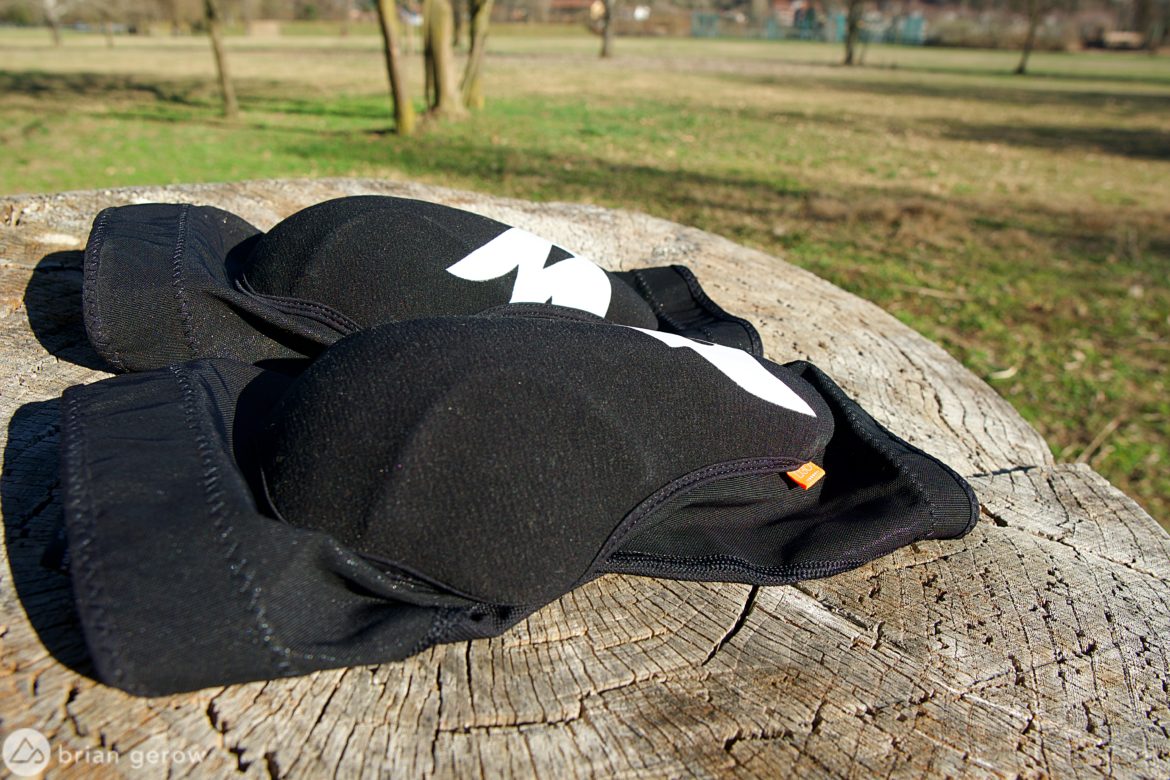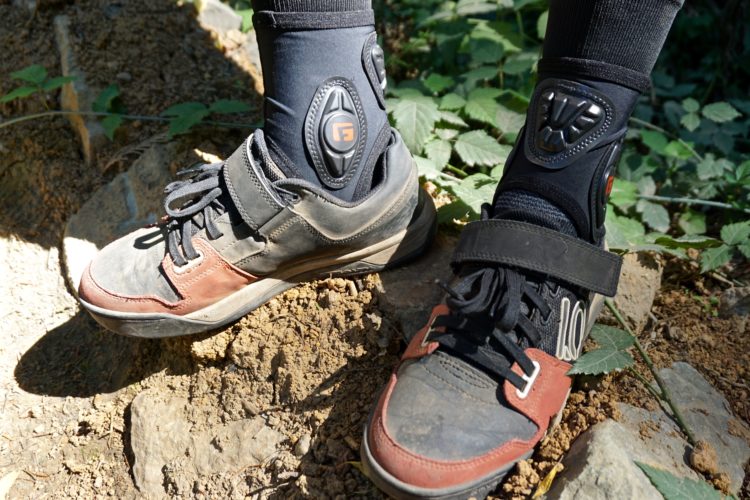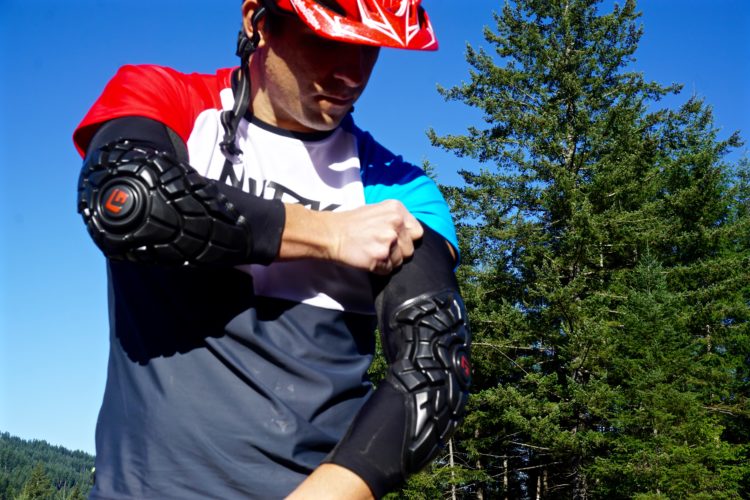
Human knees are a complex symphony of bones, ligaments, cartilage, muscles, arteries, and veins, all playing in sync to make this bipedal existence possible. How and when we choose to keep them safe is a conundrum for some mountain bikers. When should I wear my kneepads: Only at the bike park, or only after a friend injures their knee? While participating in gravity races, or any time I ride my mountain bike? My physical therapist friend likes the “always” option.

Over the winter I rode in four different sets of knee guards, each with its own intended use and protection level. Below are some details of each set in descending order, from burly park pads to a light pair designed for pedaling efficiency and comfort.
Dainese Armoform Knee Guard
- Price: $100
- Actual weight: 230g each

The Armoform pads from Dainese use the toughest protection plating and padding of the lot. Three hard polyethylene plates armadillo their way over your upper shin, knee, and lower front-thigh. A series of memory foam crash absorbers along the sides of the pad cover more of your mid-leg than not. These knee guards are ready to party.
The pads are held in place with three adjustment straps and silicone gripper strips at either end. Once cinched down tight, I did not have any trouble keeping the Armoform in place. The upper cuff of the pad sleeve is strapped a few centimeters higher than most pads I have worn, which took some getting used to. Pedaling in the Armoform guards feels a bit cumbersome, and if you want to remove these pads while you climb your shoes will have to come off too. I have found a comfortable pedaling spot with them around my ankles and didn’t need to fully remove them.

The hardshell frontal protection on the face of the pad, in place of a traditional thick foam layer, means that the rest of the sleeve can be lighter and more breathable. Every part of these protectors that is not padding is about as thin as the mesh backside of the other pads I tested, thus they breathe well and don’t make your knees uncomfortably hot. The large holes in the plastic shields provide a decent amount of airflow, and the Armoform pads will be a solid choice for summer trips to the bike park.


Bluegrass Eagle Solid D30
- Price: €120 (available at Worldwide Cyclery)
- Actual weight: 215g each

Full disclosure, the Bluegrass Eagle Solid D3O knee pads are the only set that I tested to their fullest potential. I was trying to cut my time on our steepest local track and planted my front tire in a patch of ground that some wild boar had plowed while hunting for worms and fungi. I hit the ground good and hard, at full speed, and packed a load of dirt into the Solid D30 material. I collected myself afterward and was happy to see that, apart from the large helping of imprinted soil, the pads and my knee were unscathed. The day after a dirt nap often tells where any real injuries lie, and fortunately, my knee felt healthy and ready to ride.

Bluegrass’s Solid D30 pads zip on and off so you can save some sweat on long climbs without removing your shoes. The top and bottom of the pads can be cinched tight with two adjustment straps, and the size medium gave me plenty of space for a comfortable fit. I typically wear a size small kneepad but had to size up according to the Bluegrass measurement chart. It’s always worth an extra minute with the measuring tape to get the correct size.
The lateral and medial protection in these pads felt too soft for the job until I crashed and slid on the outside of my left knee. I can say in good confidence that the overall coverage, protective strength, and build durability of these pads is spot on.
Most protective gear that is thick enough to save your skin will falter a bit in the ventilation department, and these pads are no exception. The rear of the knee is made of a breathable lycra-like material, but the large swathe of padding at the front and sides is quite warm. Fortunately, you can easily zip them off and strap them to your bike or bag while ascending.

Bluegrass Eagle Skinny D30
- Price: €100 (available at Performance Bicycle)
- Actual Weight: 166g each

The Skinny D30 pads from bluegrass Eagle are a slimmed down version of their Solid D30 cousins above. The Skinny pads slide on instead of zipping and are held in place with two silicone bands at the thigh and calf.
These pads have the same central protection as the burlier set from Bluegrass, but the lighter build sheds the pads that wrap around the sides of your knee. The Skinny D3O still offers a good amount of protection for most trail riding, and I think that they would have worked well in the aforementioned dirt nap I took.



O’Neal Flow Knee Guard
- Price: €69.99 (available on Amazon)
- Actual weight: 134g each

Now to add an all-day pedaling option in the mix. O’Neal’s Flow kneepads are the lightest offering the brand has ever made, and the lightest I tested in both weight and breathability. The Flow pads feel like a lycra knee-warmer that happens to have a large, flexible slab of protection across the front.

The protection is a honeycomb rubbery gel, covered in holes to keep things cool. It extends from the upper shin to above the kneecap and wraps around the circumference of the knee joint. It feels strong enough to be trusted in most crashes, though when you’re smashing through rock gardens, O’Neal also offers a wide variety of heavy duty protection.

For long days out on the trail, when you don’t want to remove your pads, these are a sweet bit of added protection. The Flow pads fold up and will fit nicely in a bag. They are a great choice for bikepackers who want to combine their knee-warmer and protection needs in one piece of gear.


Whether you don pads before lubing your chain, or only on lift-access days, one of these four will do a solid job of keeping those complex joints happy.
Your turn: What is the best mountain bike knee pad you’ve worn?
We would like to thank each brand for providing pads for review.




















0 Comments